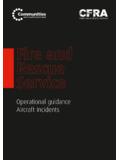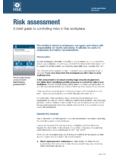Transcription of Carpool Incentive Programs - Best Workplaces for …
1 Carpool Incentive Programs :IImmpplleemmeennttiinngg CCoommmmuutteerr BBeenneeffiittss aass OOnnee ooff tthhee NNaattiioonn ss BBeesstt WWoorrkkppllaacceess ffoorr CCoommmmuutteerrssSSMMU nited States Environmental Protection AgencyOffice of Air and RadiationMarch 2005 Carpool Incentive Programs Implementing Commuter Benefits as One of the Nation s Best Workplaces for CommutersSM u Carpools consist of two or more persons driving together in a privately owned vehicle. At a workplace, employees may choose to Carpool without any assistance or involvement from the employer; however, car pool Incentive Programs are a way for employers to encourage employees to Carpool . u Carpool Incentive Programs may incorporate a variety of means to encourage employees to Carpool . Possible incentives include reduced cost or free parking, preferred parking, or reward Programs (such as prize drawings). u Employers can help employees form carpools through rideshare matching, which helps potential carpoolers locate others nearby with similar schedules.
2 Regional rideshare organizations in most areas allow interested employees to register directly for no cost. Employers can direct their employees to these free services. u Employee benefits from carpooling include cost sharing, less wear and tear on vehicles, time savings in regions with high-occupancy vehicle (HOV) lanes, and the ability to talk, eat, sleep, or read while com muting. The primary employer advantage is the need for fewer parking spaces; other advantages include less employee stress and improved productivity. u Programs to encourage carpooling, such as rideshare matching services, preferred parking for carpools, reduced parking costs for carpools, and commute awards Programs qualify as additional commuter bene fits under Best Workplaces for CommutersSM. 1 Carpool Incentive Programs : Implementing Commuter Benefits as One of the Nation s Best Workplaces for CommutersSM This document is one in a series of briefing papers designed to help employers implement commuter benefits to achieve the Best Workplaces for CommutersSM designation.
3 The Environmental Protection Agency (EPA) and the Department of Transportation (DOT) have established a voluntary National Standard of Excellence for employer-provid-ed commuter benefits. Commuter benefits help American workers get to and from work in ways that cut air pollution and global warming pollution, improve public health, improve employee recruiting and retention, improve employee job satisfaction, and reduce expenses and taxes for employers and employees. Employers that meet the program-established National Standard of Excellence are recognized as Best Workplaces for CommutersSM and agree to: u Centralize commute options information so that it is easy for employees to access and use. u Promote the availability of commuter benefits to employees. u Provide access to an emergency ride home (ERH) program. u Provide one or more of the following primary commuter benefits: Transit subsidy of at least $30 per month. Vanpool subsidy of at least $30 per month.
4 Cash in lieu of free parking worth at least $30 per month. Telework program that reduces commute trips by at least 6 percent. Other option proposed by employer and agreed to by EPA. These services must reduce the rate at which employees drive to work alone and be perceived by employees as a significant workplace benefit. u Provide three or more of the following additional commuter benefits: Active membership in a Transportation Management Association (TMA) or participation in a voluntary regional air quality management program ( , Spare the Air, Air Awareness, SEQL, Clean Air Coalition) or another employer-based commuter program. Active membership in a local ozone awareness pro gram, in which you agree to notify employees of expected poor air quality and suggest ways that they might minimize polluting behaviors. Ridesharing or Carpool matching, either in-house or through a local or regional agency. Pre-tax transit benefits.
5 Pre-tax vanpool benefits. Parking cash out less than $30 per month or less than 75 percent of the actual parking benefit. Shuttles from transit stations, either employer-provided or through a local TMA or similar service provider. Provision of intelligent ( , real-time) commuting information. Preferred parking for carpools and vanpools. Reduced parking costs for carpools and vanpools. Employer-run vanpools or subscription bus Programs . Employer-assisted vanpools. Employer-provided membership in a carsharing pro gram (visit < > to learn more). Secure bicycle parking, showers, and lockers. Electric bicycle recharging stations. Employee commuting awards Programs . Compressed work schedules. Telework (less than 6 percent of commute trips on a monthly basis). Lunchtime shuttle. Proximate commute (where employees work at loca tions closer to their homes). incentives to encourage employees to live closer to work.
6 incentives to encourage employees to use alternative transportation ( , additional vacation time). On-site amenities ( , convenience mart, dry clean ing, etc.). Concierge services. Other options proposed by employers. u In addition, employers commit to ensuring that within 18 months of applying, at least 14 percent of commute trips are taken using a mode other than driving alone. Disclaimer SMEPA provides this briefing as a service to employers participating in the Best Workplaces for Commuters. Information about pri vate service providers is intended for informational purposes and does not imply endorsement by EPA or the federal government. The information presented here does not constitute official tax guidance or a ruling by the government. Taxpayers are urged to consult with the Internal Revenue Service of the Department of Treasury or a tax professional for specific guidance related to the federal tax law. 2 Carpool Incentive Programs : Implementing Commuter Benefits as One of the Nation s Best Workplaces for CommutersSM Contents Carpool Incentive Programs : A Summary.
7 4 Employer Benefits ..4 Reduced Need for Parking ..4 Increased Productivity and Morale ..4 Tax Considerations ..4 Employee Benefits ..4 When Carpool Incentive Programs Make Sense ..4 Regions with Carpool Lanes ..4 Employers with Limited Parking ..5 Employers with Large Numbers of Employees ..5 Employers in Urban Settings ..5 Implementation Issues and Costs ..5 Rideshare Matching ..5 Preferred Parking ..5 Reduced Cost Parking ..5 Employee Schedules ..5 Potential for Fraud ..5 Other incentives ..6 Guide to Implementation ..6 Employer Questions and Answers ..8 How difficult and costly is it to administer the program? ..8 Does the employer decide who pays for gas and insurance, or how frequently each carpooler has to drive? ..8 Are there safety concerns in encouraging my employees to share rides with strangers? Are rideshare partners screened? ..8 How often must somebody Carpool before they become eligible for benefits? ..8 Employer Case Studies.
8 8 Ithaca, New York Cornell University ..8 Atlanta, Georgia Emory University ..9 Beaverton, Oregon Nike ..10 Services that Support Implementation ..10 Rideshare Organizations ..10 Parking Cash Out ..10 Emergency Ride Home Programs ..10 Park-and-Ride Lots ..11 Associations and Contacts ..11 Information Clearinghouses ..11 Rideshare Organizations ..11 Emissions and Transportation Benefits ..11 References and Publications ..12 Appendix A: Commuter Rideshare Programs ..13 Appendix B: Sample Carpooling Guidelines ..163 Carpool Incentive Programs : Implementing Commuter Benefits as One of the Nation s Best Workplaces for CommutersSM Carpool IncentivePrograms: A Summary A Carpool is a group of two or more persons who commute together in a privately owned vehicle. Employees can and do, of course, Carpool without any involvement from their employer. The focus of this paper is Carpool Incentive pro grams, in which employers actively encourage carpooling by-and usually among-their employees.
9 Carpooling benefits both employer and employee, so many companies are interested in increasing carpooling. Companies can choose among numerous ways to encourage carpooling, including reduced cost or free Carpool parking, preferred parking, rideshare matching (to identify persons leaving near each other), and financial incentives . Regional rideshare organizations can assist employees in locating potential Carpool partners. This relieves the employer of hav ing to match potential ridesharers. Employer Benefits Employers enjoy several benefits from offering Carpool Programs . Reduced Need for Parking Many employers offer Carpool Incentive Programs to reduce parking demand. Carpooling helps get employees to work without a car, especially where transit is not available. Employers can save a substantial amount of money in reduc ing the number of parking spaces required; one study esti mates that annual per-space costs vary between $360 and $2, Increased Productivity and Morale Employees who Carpool have less commute-related stress, and therefore improved morale and productivity.
10 In regions with Carpool lanes, carpoolers can avoid congestion, its delays, and the congestion-induced unpredictability that interferes with scheduling. Tax Considerations Tax provisions that allow Carpool parking costs to be taken as a tax-free fringe benefit offer potential financial savings for both employers and Parking benefits may be provided tax-free to employees up to $200 per month. Tax benefits accrue to businesses and employees whether the employer pays for the benefits or the employee pays for it through a pre-tax salary deduction. If parking costs are less then $200, parking benefits can only equal the actual cost of parking. However, any employee who drives to work is eligible for these benefits, not just Carpool ers. For more detailed information on how pre-tax Programs work see the briefing paper Commuter Tax Benefits. Employee Benefits Employees enjoy several benefits from carpooling: uuReduced costs. Carpoolers save on gas, depreciation, and general wear and tear on their vehicles.






